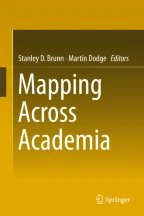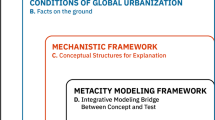Making Sense of Cities: The Role of Maps in the Past, Present, and Future of Urban Planning

Cities are by definition complex and dynamic physical and social systems. Professionals charged with planning for and building our constantly-changing cities, including urban planners and designers, depend upon a wide range of maps and spatial technologies to make decisions. Planning is essentially a visual and spatial discipline where ideas, plans, arguments and empirical analyses are all expressed through paper and digital maps , including GIS (geographic information systems) . This chapter critically explores the way professional and academic planners who work in transportation, community and economic development , international development , environmental conservation , real estate and urban use maps at all scales . Maps will continue to be critical in planners’ efforts to understand the spatial form of cities and how residents conceive of places , make and analyze plans, model social and environmental impacts, engage citizens and hold government officials accountable. The interdisciplinary fields of public health , energy and sustainability and civic engagement are examined as opportunities for future collaboration.
This is a preview of subscription content, log in via an institution to check access.
Access this chapter
Subscribe and save
Springer+ Basic
€32.70 /Month
- Get 10 units per month
- Download Article/Chapter or eBook
- 1 Unit = 1 Article or 1 Chapter
- Cancel anytime
Buy Now
Price includes VAT (France)
eBook EUR 128.39 Price includes VAT (France)
Softcover Book EUR 168.79 Price includes VAT (France)
Hardcover Book EUR 168.79 Price includes VAT (France)
Tax calculation will be finalised at checkout
Purchases are for personal use only
Similar content being viewed by others

Setting the Scene: The Geographies of Urban Governance
Chapter © 2015

Conceptual frameworks facilitate integration for transdisciplinary urban science
Article Open access 23 February 2021

Research on Urban and Regional Systems: Contributions from GIS&T, Spatial Analysis, and Location Modeling
Chapter © 2020
Suggested Readings
- Drummond, W. J., & French, S. P. (2008). The future of GIS in planning: Converging technologies and diverging interests. Journal of the American Planning Association,74(2), 161–174. ArticleGoogle Scholar
- Lynch, K. (1960). The image of the city. Cambridge: M.I.T. Press. Google Scholar
- Walker, D., & Daniels, T. (2011). The planners’ guide to communityviz. APA Planners Press and the Orton Family Foundation. Google Scholar
References
- Bessis, N., Asimakopoulou, E., French, T., Norrington, P., & Xhafa, F. (2010). The big picture, from grids and clouds to crowds: A data collective computational intelligence case proposal for managing disasters. In P2P, parallel, grid, cloud, and Internet computing, international conference, pp. 351–356. Google Scholar
- Bollens, S. A. (2004). Urban planning and intergroup conflict: Confronting a fractured public interest. In B. Stiftel & V. Watson (Eds.), Dialogues in urban & regional planning. New York: Routledge. Google Scholar
- Bugs, G., Garnell, C., Fonts, O., Huerta, J., & Painho, M. (2010). An assessment of public participation GIS and Web 2.0 technologies in urban planning practice in Canela, Brazil. Cities,27, 172–181. ArticleGoogle Scholar
- Cope, M., & Elwood, S. (Eds.). (2009). Qualitative GIS: A mixed-methods approach. Thousand Oaks, CA: Sage. Google Scholar
- Craig, W. J., Harris, T. M., & Weiner, D. (Eds.). (2002). Community participation and geographical information systems. New York: Taylor & Francis Inc. Google Scholar
- Diep, F. (2011). Amateur cartographers map local ‘food desert’. Scientific American, February 28. Available at http://www.scientificamerican.com/article.cfm?id=mapping-the-food-desert
- Dodgson, J. S. (2009). Multi-criteria analysis: A manual. London: Department for Communities and Local Government. Google Scholar
- DVRP (Delaware Valley Regional Planning Association). (2011). http://www.dvrpc.org/GetInvolved/TitleVI/
- ESRI. (2010). Changing geography by design: Selected readings in geodesign. Redlands, CA: ESRI. Google Scholar
- Evans, G. W., Brennan, P. L., Skorpanich, M. A., & Held, D. (1984). Cognitive mapping and elderly adults: Verbal and location memory for urban landmarks. Journal of Gerontology,39(4), 452–457. ArticleGoogle Scholar
- FEMA (Federal Emergency Management Agency). (2010 and 2011). HAZUS-MP. http://www.fema.gov/plan/prevent/hazus/hz_overview.shtm
- Fishman, R. (1998). Beyond utopia: Urbanism after the end of cities. In Ciutat real, ciutat ideal. Significat i funció a l’espai urbà modern [Real city, ideal city. Signification and function in modern space.] Barcelona: Centre de Cultura Contemporània de Barcelona, 1998 (Urbanitats; 7). Available at http://www.cccb.org/rcs_gene/beyond_utopia.pdf
- Forsyth, A., Slotterback, C. S., & Krizek, K. (2010). Health Impact Assessment (HIA) for planners: What tools are useful? Journal of Planning Literature,24, 231. ArticleGoogle Scholar
- Foth, M., Bajracharya, B., Brown, R., & Hearn, G. (2009). The second life of urban planning? using NeoGeography tools for community engagement. Journal of Location Based Services,3(2), 97–117. ArticleGoogle Scholar
- Golledge, R. G. (Ed.). (1999). Wayfinding behavior. Cognitive mapping and other spatial processes. Baltimore: Johns Hopkins University Press. Google Scholar
- Guest, A. M., & Lee, B. A. (1984). How urbanites define their neighbourhoods. Population and Environment,7(1), 32–56. ArticleGoogle Scholar
- Hadhazy, A. (2010). Lasers used to create 3-D model of New York City. TechNewsDaily, May 12. Available at http://www.technewsdaily.com/lasers-used-to-create-3-d-model-of-new-york-city-0548/
- Halseth, G., & Doddridge, J. (2000). Children’s cognitive mapping: A potential tool for neighbourhood planning. Environment and Planning B: Planning and Design,27(4), 565–582. ArticleGoogle Scholar
- Harris, C. D., & Ullman, E. L. (1945). The nature of cities. Annals of the American Academy of Political and Social Science,242, 7–17. ArticleGoogle Scholar
- Hernandez, J. (2009). Redlining revisited: Mortgage lending patterns in Sacramento 1930–2004. International Journal of Urban and Regional Research,33(2), 291–313. ArticleGoogle Scholar
- Hillier, A. (2003). Redlining and the home owners’ loan corporation. Journal of Urban History,29(4), 394–420. ArticleGoogle Scholar
- Hillier, A., & Culhane, D. (2012). GIS applications and administrative data to support community change. In M. Weil (Ed.), Handbook of community practice (2nd ed.). Thousand Oaks, CA: Sage. Google Scholar
- Hillier, A., Wernecke, M., & McKelvey, H. (2005). Removing barriers to the use of community information systems. Journal of Community Practice,13(1), 121–139. ArticleGoogle Scholar
- Hospers, G. (2010). Lynch’s The Image of the City after 50 years: City marketing lessons from an urban planning classic. European Planning Studies,18(12), 339–349. ArticleGoogle Scholar
- Howard, E. (1898). To-morrow: A peaceful path to real reform. London: Swan Sonnenschein. Google Scholar
- Howard, E. (1902). Garden cities of to-morrow. London: Swan Sonnenschein. Google Scholar
- Hoyt, H. (1939). The structure and growth of residential neighborhoods in American Cities. Washington, DC: Federal Housing Administration. Google Scholar
- Kwan, M. (2002). Feminist visualization: Re-envisioning GIS as a method in feminist geographic research. Annals of the Association of American Geographers,92(4), 645–661. ArticleGoogle Scholar
- Kwan, M., & Lee, J. (2005). Emergency response after 9/11: The potential of real-time 3D GIS for quick emergency response in micro-spatial environments. Computers, Environment and Urban Systems,29, 93–113. ArticleGoogle Scholar
- Landis, J. D., & Zhang, M. (2000). Using GIS to improve urban activity and forecasting models: Three examples. In S. A. Fotheringham & M. Wegener (Eds.), Spatial models and GIS: New potential and new methods. London: Taylor and Francis. Google Scholar
- Lee, J., & Niu, M. (2011). Multiplayer gaming as a tool to build better communities. Proposal to the Graduate and Professional Student Association, University of Pennsylvania. Google Scholar
- Ligmann-Zielinska, A., & Jankowski, P. (2007). Agent-based models as laboratories for spatially explicit planning policies. Environment and Planning B: Planning and Design,34(2), 316–335. ArticleGoogle Scholar
- Marquis. (2011). CenTrax. Available at http://www.gomarquis.com/fair-lending-hmda-and-cra-software.aspx
- Matthews, S. A., Detwiler, J. E., & Burton, L. M. (2005). Geo-ethnography: Coupling geographic information analysis techniques with ethnographic methods in urban research. Cartographica,40(4), 75–90. ArticleGoogle Scholar
- NNIP (National Neighborhood Indicators Partnership). (2011). http://www2.urban.org/nnip/foreclosures.html
- Northridge, M. E., & Sclar, E. (2003). A joint urban planning and public health framework: Contributions to health impact assessment. American Journal of Public Health,93(1), 118–121. ArticleGoogle Scholar
- Park, R., Burgess, E. W., & McKenzie, R. D. (1925). The city. Chicago: University of Chicago Press. Google Scholar
- Perry, C. (1929). The neighbourhood unit as seen by Clarence A. Perry. New York Regional Survey, Vol. 7. Google Scholar
- Pickles, J. (1995). Ground truth: The social implications of geographic information systems. New York: The Guilford Press. Google Scholar
- PlaNYC. (2009). A greener, greater New York. New York City: Planning Commission. Google Scholar
- Sloane, D. (2006). From congestion to sprawl: Planning and health in historical context. Journal of the American Planning Association,72(1), 10–18. ArticleGoogle Scholar
- Squires, G. (Ed.). (1992). From redlining to reinvestment: Community responses to urban disinvestment. Philadelphia: Temple University Press. Google Scholar
- Tomlin, C. D. (1990). Geographic information systems and cartographic modeling. New Jersey: Prentice Hall College Division. Google Scholar
- Walker, D., & Daniels, T. (2011b). The planners guide to communityviz: The essential tool for a new generation of planning. Chicago: APA Planners Press. Google Scholar
- Zwick, P. (2010). The world beyond GIS. Planning,76(6), 20–23. Google Scholar
Author information
Authors and Affiliations
- School of Design, University of Pennsylvania, Philadelphia, PA, USA Amy Hillier
- Amy Hillier


